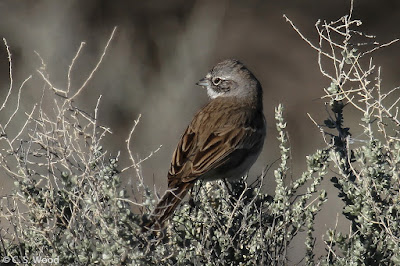Arizona, of course, is a birders' Mecca, and the opportunities to improve birding skills here are obvious. Here you may find several groups of birds that provide time-honored identification challenges to birders. These apply even to long-time birders, such as yours truly, when afield mostly alone in unfamiliar territory. Here's a few examples.
Empids
Empidonax flycatchers are notoriously difficult to separate by species except (usually) by voice, but then only if they are singing or calling, duh. Which they often are not, especially out of breeding season. Here are two closely related empids.
Dusky Flycatcher
Gray Flycatcher
When I first saw and photographed the Dusky Flycatcher, I posted it on the Arizona bird reports with a request for ID opinion. Only three empids should be expected in Arizona in Winter: Dusky, Gray, and Hammond's. The latter can be ruled out based on the bill size (Hammond's is distinctly smaller). Opinion was divided on the other two options, but my friend Jay Hand educated me on the kicker: Gray tail flicks down, Dusky flicks up. So when I ran into a Gray Flycatcher at Catalina State Park, I was ready, and the ID was easy. note also the rounded head of the Dusky compared to the flatter head of the Gray, as pointed out in the Sibley Guide.
There are other subtle plumage hints with empids. In this case, white edges to outer tail feathers on the Gray; brighter lores on the Dusky; and shorter primary wing feather extension on the Dusky than the Gray. Needless to say, these can be difficult to distinguish looking into the sun at a quickly vanishing bird.
Mimic Thrushes
Thrashers can provide another challenge, not least due to the reluctance of most of them to pose for close observation. With enough experience and good ears, most may be distinguished by their songs. But fresh off the plane and into the desert, it takes a while to get the songs down. Getting photos is not much easier, and while I saw several Le Conte's Thrashers, none would sit for a portrait. However, the primary ID points for Le Conte's are characteristics essentially opposite those of the Crissal Thrasher, which is of similar size and bill shape. Le Conte's have sandy pale plumage and dark iris; Crissal have darker plumage and pale iris.
Crissal Thrasher
Bendire's Thrasher
Bendire's Thrasher has an obviously shorter and straighter bill, as does the Sage Thrasher, which regrettably I was unable to photo on this trip. And the most common and widespread thrasher, at least in the more developed areas like golf courses, is the Curve-billed. Not as curved as the Crissal, but more curved than Bendire's. And I just really noticed from these shots, iris color gradation seems to go from all dark in LeConte's, to rather puce in Crissal, to dull orange in Bendire's, to lemon yellow in Curve-billed and Sage. I expect in the field there is more variation due to lighting, etc., so I don't suggest this as a field ID trick.
Curve-billed Thrasher
Sage Sparrows
A well-known birding spot where most of these Thrashers can be found, called the Baseline/Salome Thrasher Site west of Phoenix, also is home to about a million White-crowned Sparrows, eight or ten Sagebrush Sparrows, and, unfortunately, zero Bell's Sparrows (numbers are estimates for illustrative purposes only). Bell's are actually found there, just not on the days I visited.
Close looks can separate Bell's and Sagebrush Sparrow, until recently considered just one species, and this one photo does highlight the distinctions: Sagebrush has streaking on the back and a weak throat stripe while Bell's shows a broad black throat stripe and plain back.
Sagebrush Sparrow
Vireo/Kinglet
One more. Hutton's Vireo vs. Ruby-crowned Kinglet. Both are little yellowish jobs (as distinct from little brown jobs which will be a subject for a future post); both are highly active, and both have two white wingbars and a broken white eye-ring. Of course if the Kinglet shows its red crown, ID is unmistakeable. Otherwise, the Vireo's heavy bill and the black bar below the wing bar on the Kinglet provide the necessary clues.
Hutton's Vireo
Ruby-crowned Kinglet
Dealing with these kinds of challenges is one of the great appeals of birding, providing an intellectual stimulation that complements the pure aesthetic enjoyment of the color, behavior, song, and spirit of birds.








Comments
Post a Comment